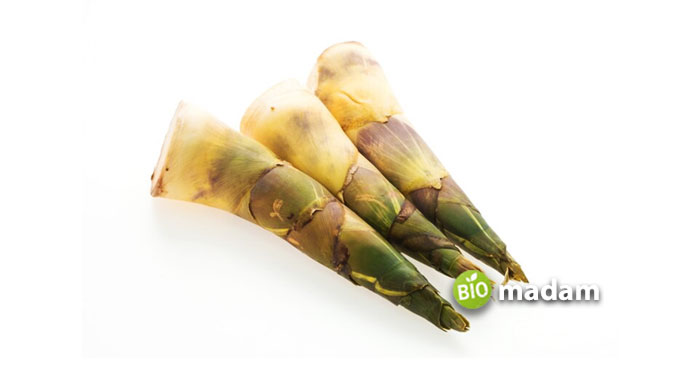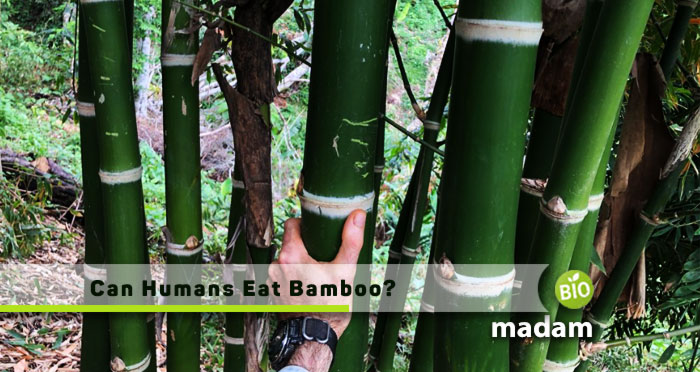Bamboo has always been known as a dry, tall, stiff plant. Despite being a part of various regional dishes, bamboo has not been widely used. However, now people are curious about pandas feeding on bamboo and wondering how humans can eat the same. Besides asking, “Why do pandas eat bamboo?” people have been wondering, “Can humans eat bamboo like pandas?”
Though you might be surprised to know that humans can eat bamboo, it has various health benefits that we will share in this article.
What is Bamboo?
Before we dive into the details of “Can humans eat bamboo,” what exactly is bamboo?
Bamboo refers to 1,718 long, stiff grass species growing throughout Asia, America, and Africa. It belongs to the Poaceae family and is found in tropical and cold climates. Besides serving as food for pandas, bamboo is also used in paper making and building houses. They grow fast, making them a suitable choice for these needs. Plus, bamboo is widely used in Chinese, Burmese, and Filipino cooking.
How does Bamboo Taste?
Bamboo’s taste may vary depending on the species and preparation method. However, it typically has a slightly sweet and mild flavor; it is crunchy despite boiling. Furthermore, bamboo shoots take the flavor of other ingredients when cooking because of their mild flavor. Thus, they are often used in various cuisines for their crunchy texture and nutritional value.
Nutrients in Bamboo
Talking of the nutritional value of bamboo, there are no fixed overall numbers because of so many varieties. However, bamboo generally has iron, copper, potassium, calcium, chromium, manganese, zinc, thiamine, niacin, and vitamins A, B6, and E.
Half a cup of fresh bamboo slices approximately contains:
- Calories: 20
- Protein: 2 grams
- Fat: 0 grams
- Carbohydrates: 4 grams
- Sugar: 2 grams
- Fiber: 2 grams
- Sodium: 3 milligrams
Can Humans Eat Bamboo?
As we mentioned, yes, humans can eat bamboo. But only 101 species out of 1,718 have edible shoots.
Also, you cannot eat bamboo shoots just after removing them from the ground; eating raw bamboo can be toxic.
Bamboo has a toxin that produces Taxiphyllin (cyanogenic glycosides) when ingested or digested, which can make you sick. Eating higher amounts of raw bamboo can even prove to be deadly. Yet the toxin deteriorates fast in boiling water. So, you must always cook the bamboo shoots before eating them to eliminate the chances of toxicity.
However, canned bamboo shoots do not require cooking; eat them straight out of the can or add them to your favorite dishes. In case you feel the canned shoots smell weird, blanch them for a few minutes before eating.
Do Humans Eat Bamboo?
Though you know the answer to “Can humans eat bamboo shoots?” is yes, who eats bamboo?
Bamboo has been an important part of Asian cuisine for a long time. As humans explored more ingredients, the use of bamboo in cooking has reduced over the past years. However, people are again searching for ways to use bamboo to get the nutritional benefits.
You might have also heard of the legend that says eating bamboo can help increase your height. Mothers often give bamboo shoots to children of growing age to ensure they grow tall like the bamboo!
Health Benefits of Bamboo for Humans
Improves Digestion
Bamboos have a high concentration of cellulose that stimulates appetite and helps improve digestion. Eventually, it helps prevent constipation.
Boosts Immunity
Moreover, bamboo contains a wide variety of minerals and vitamins, which help strengthen immunity. Adding bamboo shoots to your diet can help you fight antigens and pathogens more effectively.
Strengthens Bones
The high amount of phosphorus and potassium in bamboo shoots makes them a perfect bone-strengthening supplement. Furthermore, they contribute to muscle strength, maintaining healthy blood pressure, and cardiac health.
Lowers Cholesterol
Bamboo shoots are considered an excellent source of fiber; they help lower cholesterol and LDL. So, they reduce the atherogenic index, decreasing your chances of heart disease.
Helps Lose Weight
Bamboo shoots have only 8 grams of carbohydrates out of a total calories of 40 per bowl. It makes shoots the perfect snack to munch on when you want to enjoy a guilt-free diet. Thus, they help you lose weight by replacing high-calorie options with bamboo shoots.

Stabilizes Hormones
Bamboo shoots are rich in lignans that help stabilize estrogen in women and testosterone in men; gut bacteria transform the lignans to stabilize hormones.
Facilitates Normal Delivery
Many expecting women in China add bamboo shoots to their diet in the last trimester. They stimulate uterine contractions that can lead to a normal delivery.
Anti Venomous
Ayurvedic applications of bamboo suggest its use in flushing out venom from a snake or scorpion bite. Drink bamboo shoot juice and apply it on the bite wound to eliminate the poison and facilitate healing.
Detoxifies & Improves Skin
Besides being anti-venomous, bamboo has anti-inflammatory properties. Thus, it is considered ideal for skin rejuvenation and cell growth. Furthermore, it helps in elastin and collagen synthesis. The anti-aging properties have made bamboo an important skin care product ingredient.
How to Prepare Bamboo for Consumption?
You may be happy to know the answer to “Can humans eat bamboo shoots” finally. But, as we mentioned, preparing bamboo shoots properly is crucial to health.
To prepare bamboo shoots for eating, you must remove the toxins by boiling them in water. The best way is to heat them at 98–102°C (208-215 °F) in water for 148–180 minutes. It will kill 97% of the cyanide in the shoots.
Sometimes, measuring the temperatures so accurately can be difficult. So, you can bring the water to a boil and leave the bamboo shoots in boiling water for one to two hours. Boiling them for half an hour at the temperature will kill 70% of the cyanide; cooking for more time ensures the bamboo is not toxic anymore.
Here’s how to prepare and cook bamboo shoots for consumption:
- Peel the bamboo and remove the outer layer.
- Add salt to the water and bring it to a boil.
- Add the bamboo shoots to the boiling water and let them cook for half an hour to two hours at medium-low heat.
- Use a skewer to check if they are soft enough.
- Take the bamboo out of the water and let them cool.
Eat the bamboo shoots on their own or add them to meals of your choice, like stir-fry and dumplings. Alternatively, store the bamboo in the refrigerator for up to a week to avoid repeating the boiling process frequently.
Alternative Ways to Prepare Bamboo
Freezing and Oven Drying
Besides boiling, you can also prepare bamboo by soaking them in water. Soaking them for 24 hours removes 80% of the cyanide. Otherwise, freeze them at -50°C (-58°F) for 24 hours or oven dry the shoots at 60°C (122°F) for 8 hours to remove 95% of cyanide.
Soaking and Sun Drying
To prepare bamboo for crafting, soak it for 2 – 3 days and sun dry it for around a week. Bamboo straw producers do the same to prepare bamboo for making straws.
Types of Bamboo for Consumption
Fresh Bamboo Shoots
As mentioned, fresh bamboo shoots come directly from the plant. However, they cannot be consumed without boiling or oven-drying to remove cyanide.
Canned/Prepared Bamboo Shoots
Many supermarkets have prepared or canned bamboo shoots you can take home and relish. They are usually sliced, but you can get whole, chopped, or crushed canned bamboo shoots.
Winter Bamboo Shoots
Winter bamboo shoots are collected in winter when they are sweeter, shorter, and softer. These bamboo shoots are bigger and sold in vacuum packs.
Green Bamboo Shoots
Green bamboo shoots are premium varieties sold at higher rates. They can be easily sliced into any shape of choice. However, despite the name, they are white, not green.

Thin Bamboo Shoots
As the name indicates, these bamboo shoots from P. bambusoides plant are thin and long. They have a slightly bitter taste, unlike the usual mild, sweet taste, and contain higher fiber content.
Salted Dried Bamboo
Salted dried bamboos are prepared by drying and adding salt to them. So, you need to soak them in water before eating. You can find salted, dried bamboo in plastic vacuum-pack containers in markets.
Sour Bamboo Shoots
Sour bamboo shoots are salt-fermented shoots widely used as a seasoning in Southeast Asia. You can add it to soups, stir-fry, and other dishes.
Negative Effects of Bamboo Shoots on Health
Bamboo is of high nutritional value for humans and pandas. Yet, if not prepared properly, it might result in some adverse health effects in humans, like:
Causes Stomach Issues
Studies have shown that patients with stomach pain may have chronic episodes due to eating bamboo. As the shoots contain a high amount of cyanhydric acid, improper preparation or cooking can harm the stomach, especially for people already suffering from stomach pain.
Impacts Thyroid Function
Consuming too many bamboo shoots can affect thyroid function as they are goitrogenic. They decrease the activity of the gland cells that produce thyroid hormones, ultimately impacting your thyroid function. Cooking bamboo shoots properly can help avoid the issue. Furthermore, adding iodine and selenium to your diet can also improve thyroid function.
Can be Lethal
As mentioned, improperly prepared or cooked bamboo may contain cyanide, leading to cyanide poisoning and death. Confusion, difficulty in breathing, nausea, seizures, and loss of consciousness may indicate cyanide poisoning. One kg of bamboo contains 100 milligrams to one gram of cyanide, and studies show 200 – 300 mg is enough to kill. So, always prepare and cook fresh bamboo thoroughly before ingesting it.
Why do Pandas Eat Bamboo?
We mentioned that raw bamboo has Taxiphyllin, which can be toxic, but we have all also seen chubby pandas eating bamboo. So, how can pandas eat bamboo?
Unlike humans, pandas do not get sick from eating raw bamboo as they can neutralize cyanide. Giant pandas intake more than 65% of the cyanide in the shoots, but their bodies turn 80% of the absorbed cyanide into a weak chemical called thiocyanate. It is not as toxic as taxiphyllin; the pandas just pee it out.
So, if you wonder, “Can humans eat bamboo like pandas?” Pandas can eat raw bamboo, whereas humans cannot.
The Bottom Line
Pandas have eaten bamboo for years, but people often wonder, “Can humans eat bamboo like pandas?” It might surprise some, but yes, humans can eat bamboo, not the same as pandas though. Bamboo is typically hard and dry and contains cyanogenic glycosides, which can be toxic for humans. So, humans cannot eat bamboo raw like pandas. You must boil bamboo shoots according to the method mentioned in the article to remove the cyanide. Once prepared, eat them as snacks or add the crunchy bamboo shoots to your favorite dishes and enjoy!
FAQs
Can humans eat bamboo leaves?
Commonly, bamboo leaves are not eaten like bamboo shoots. Humans can eat bamboo leaves but are also toxic in raw form. You must wash, prepare, and cook them like shoots to make them edible. Bamboo leaves have vitamins A, B6, E, niacin, and thiamine.
How to detect cyanide in bamboo shoots?
You can detect cyanide in bamboo shoots and other parts like sorghum leaves and cassava roots by placing the shoots in a container with filter paper. The container also has a piece of picrate paper and the catalyst. Leave them together overnight. Color changes in the picrate paper indicate the level of poison in the shoots.
Is bamboo poisonous to pets?
Bamboo is not poisonous to pets. So, you do not have to worry if you have any bamboo variety at home. However, ensure you do not mistake Heavenly Bamboo or Lucky Bamboo for the bamboo plant; they can be dangerous to cats and dogs. Your pet may show symptoms like increased heart rate, discomfort, drooling, loss of appetite, weakness, and vomiting on ingesting.
What animals eat bamboo?
Bamboo is not harmful to many animals b and is thus a part of their diet. Pandas are the most commonly known bamboo-eating plants. However, chimpanzees, elephants, guinea pigs, rabbits, bamboo partridges, giraffes, bamboo worms, and many other animals also devour this plant.

Hi, my name is Eva. I am currently practicing as a clinical social worker, that being my childhood desire. As a licensed therapist holding MPhil in Clinical Psychology, I am now on biomadam to provide the natives with the best family advice! Do you have any questions? See you in the comment section.

